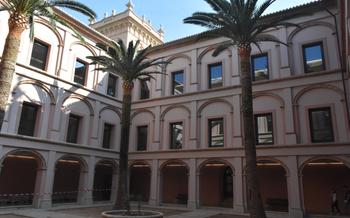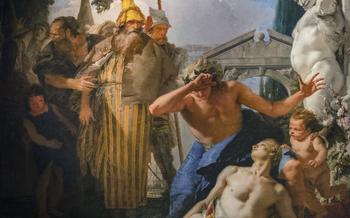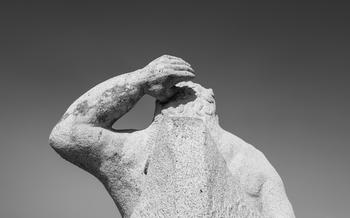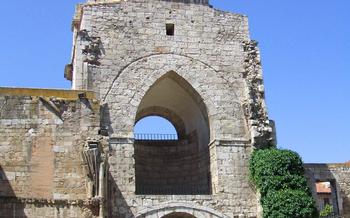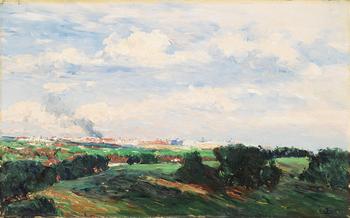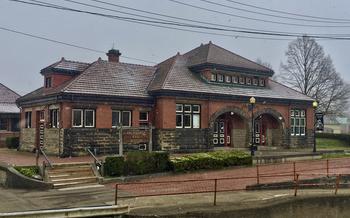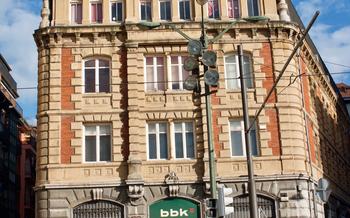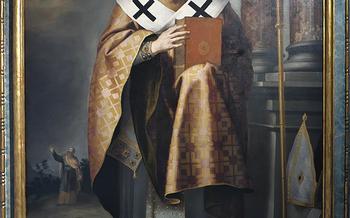
Museo de Bellas Artes de Granada
- Museo de Bellas Artes de Granada
- The Spanish Masters
- The Renaissance and Baroque Periods
- Special Exhibitions
- Educational Programs
- Accessibility
- Location
- Guided Tours
- Museum Shop
- Hours and Days of Operation
- Photography and Videography
- Insider Tip
Museo de Bellas Artes de Granada
Founded in 1839, the Museo de Bellas Artes de Granada is one of the most important art museums in Andalusia, Spain. Located in the heart of Granada, just a short walk from the city's iconic cathedral, the museum houses a vast collection of over 2,000 works of art, spanning from the Middle Ages to the present day. Highlights of the collection include paintings by El Greco, Zurbarán, Murillo, and Goya, as well as works by Italian and Flemish masters such as Botticelli, Van Dyck, and Rubens. The museum also has a significant collection of 19th- and 20th-century art, including works by Sorolla, Miró, and Dalí.
The Museo de Bellas Artes de Granada is a must-see for any art lover visiting the city. The museum's collection is world-class, and the building itself is a beautiful example of Renaissance architecture. Whether you're interested in ancient, medieval, modern, or contemporary art, you're sure to find something to enjoy at the Museo de Bellas Artes de Granada.
The Spanish Masters
The Museo de Bellas Artes de Granada boasts an impressive collection of Spanish art, spanning from the Middle Ages to the 19th century. The museum houses masterpieces by some of the most renowned Spanish artists, including El Greco, Zurbarán, Murillo, and Goya.
El Greco, a 16th-century artist known for his elongated figures and vibrant colors, is represented by several works in the museum, including his iconic painting The Agony in the Garden. Zurbarán, a 17th-century artist known for his naturalistic style and religious subjects, is represented by works such as Saint Francis in Ecstasy. Murillo, a 17th-century artist known for his sweet and sentimental paintings, is represented by works such as The Immaculate Conception. Goya, an 18th-century artist known for his dark and satirical works, is represented by works such as The Third of May 1808.
The Spanish school of painting had a profound influence on European art, and the Museo de Bellas Artes de Granada provides a unique opportunity to learn about this important artistic tradition. The museum's collection of Spanish art is a must-see for anyone interested in the history of art.
The Renaissance and Baroque Periods
The Museo de Bellas Artes de Granada has a rich collection of Italian and Flemish paintings from the Renaissance and Baroque periods, which are showcased in dedicated galleries. One of the highlights of this collection is the painting "The Annunciation" by the Italian master Sandro Botticelli. This exquisite work depicts the moment when the angel Gabriel appears to the Virgin Mary to announce that she will give birth to Jesus Christ. The painting is known for its delicate brushwork, vibrant colors, and serene composition, and it is considered one of the most important works of the Italian Renaissance in the museum.
Another masterpiece from this period is "The Descent from the Cross" by the Flemish painter Anthony van Dyck. This powerful and moving painting portrays the moment when Jesus' body is taken down from the cross after his crucifixion. The painting is characterized by its dramatic lighting, expressive figures, and intense emotion, and it is considered one of the most important works of the Flemish Baroque in the museum.
The collection also includes works by other notable artists from the Renaissance and Baroque periods, such as Titian, Tintoretto, El Greco, and Rubens. These works provide a comprehensive overview of the artistic developments and styles of this era, and they offer visitors a chance to admire some of the most famous and influential paintings from this period.
Special Exhibitions
The Museo de Bellas Artes de Granada presents a dynamic program of temporary exhibitions that complement its permanent collection and showcase a wide range of artistic styles and periods. These exhibitions often feature works from other museums, private collections, and contemporary artists, offering visitors a fresh perspective on art history.
Past exhibitions have explored topics such as the influence of Islam on Spanish art, the development of landscape painting in the 19th century, and the role of women in the art world. Upcoming shows include a retrospective of the work of the Spanish artist José Guerrero and an exhibition of contemporary photography from Latin America.
To find out about upcoming exhibitions, visitors can check the museum's website or follow its social media channels. The museum also offers a variety of educational programs and events related to its temporary exhibitions, such as lectures, guided tours, and workshops.
Educational Programs
The Museo de Bellas Artes de Granada offers a variety of educational programs for children and adults. These programs are designed to promote an understanding of and appreciation for the visual arts.
For children, the museum offers workshops and guided tours that focus on specific artworks or art techniques. These programs are designed to be interactive and engaging, and they allow children to learn about art while having fun.
For adults, the museum offers lectures and workshops on a variety of topics related to art history and appreciation. These programs are led by experts in the field, and they provide a great opportunity to learn more about the museum's collection and the history of art.
To book an educational program, please visit the museum's website or contact the education department directly.
Accessibility
The Museo de Bellas Artes de Granada is committed to making its collection and exhibitions accessible to all visitors, regardless of their abilities. The museum offers a variety of accessibility features, including wheelchair access, audio guides, and sign language interpretation.
Wheelchair users can access the museum through a ramp at the main entrance. Once inside, the museum's galleries are all wheelchair accessible, and there are elevators to reach the upper floors.
Audio guides are available in English, Spanish, and French. They provide detailed descriptions of the museum's collection, including information about the artists, the works of art, and the historical context.
Sign language interpretation is available for guided tours and educational programs. Visitors who need sign language interpretation should request it in advance.
To request accessibility services, please contact the museum's visitor services department at [email protected] or by phone at +34 958 225 35
Location
The Museo de Bellas Artes de Granada is located in the heart of the city, in the historic Realejo district. The museum is housed in a beautiful 16th-century palace, the Palacio de Carlos V, which is worth a visit in its own right. The museum is surrounded by other cultural attractions, such as the Granada Cathedral, the Alhambra, and the Plaza Nueva.
The museum is easily accessible by public transportation. The nearest bus stop is called "Realejo", and the nearest metro stop is called "Alhambra". The museum is also within walking distance of the city center.
If you are driving to the museum, there are several parking garages nearby. The closest parking garage is called "Parking Carlos V".
Guided Tours
The Museo de Bellas Artes de Granada offers guided tours in English and Spanish, allowing visitors to explore the museum's highlights and hidden gems with an expert guide. The tours are led by knowledgeable and passionate docents who bring the artwork to life with their insights and stories.
Tours typically last around 90 minutes and cover a wide range of works from the museum's collection, including masterpieces by Spanish masters such as El Greco, Zurbarán, Murillo, and Goya, as well as works by Italian and Flemish artists from the Renaissance and Baroque periods.
To book a guided tour, visitors can either reserve online in advance or purchase tickets at the museum's ticket counter. Tours are available at various times throughout the day, and reservations are recommended to ensure a spot.
During the tour, visitors will have the opportunity to ask questions, learn more about the artists and their techniques, and gain a deeper understanding of the historical and cultural context of the artwork. Guided tours are an excellent way to make the most of your visit to the Museo de Bellas Artes de Granada and to discover the stories behind the masterpieces.
Museum Shop
The Museo de Bellas Artes de Granada has a well-stocked museum shop where you can find a variety of souvenirs to remember your visit. The shop is located on the ground floor of the museum and offers a wide selection of items, including books, prints, postcards, jewelry, and other gift items.
The bookshop has a good selection of art books, both in Spanish and English. There are also a number of books on the history of the museum and the city of Granada. The prints and postcards feature works of art from the museum's collection, as well as images of the city. The jewelry is all handmade by local artisans and features a variety of designs inspired by the museum's collection.
The museum shop is a great place to find unique and memorable gifts for yourself or for friends and family. The staff is friendly and helpful, and they are always happy to answer any questions you may have.
Hours and Days of Operation
The Museo de Bellas Artes de Granada is open to the public from Tuesday to Sunday, from 11 am to 8 pm. On Mondays, the museum is closed, except for public holidays. It is also closed on certain holidays, such as Christmas Day and New Year's Day.
During the summer months (June to September), the museum extends its hours and stays open until 9 pm. This is a great time to visit the museum, as the weather is warm and the crowds are smaller.
If you are planning a visit to the Museo de Bellas Artes de Granada, it is a good idea to check the museum's website or call ahead to confirm the hours of operation. This will help you avoid any disappointment if the museum is closed unexpectedly.
Photography and Videography
The Museo de Bellas Artes de Granada has a strict policy regarding photography and videography within its premises. Photography is allowed for personal, non-commercial use, provided that it does not interfere with the enjoyment of other visitors or damage the artwork. However, the use of tripods, flash, and selfie sticks is prohibited.
Professional photography or videography for commercial purposes requires prior permission from the museum administration. This includes photography or videography for advertising, editorial, or any other commercial use. To obtain permission, you must submit a written request to the museum, specifying the intended use of the images or footage and the date and time of your shoot.
It is crucial to respect the museum's policies and guidelines to ensure that everyone can enjoy the artworks and the museum experience. By adhering to these rules, you help preserve the integrity of the collection and contribute to the museum's ongoing mission of promoting and preserving art.
Insider Tip
For a unique perspective of the city, head to the museum's rooftop terrace. Here, you'll find stunning views of the Alhambra, the Sierra Nevada mountains, and the city of Granada. It's the perfect spot to relax and soak in the beauty of this historic city.
Another hidden gem in the museum is the collection of paintings by José María Rodríguez-Acosta. Acosta was a Spanish painter who lived in Granada in the late 19th and early 20th centuries. His works are known for their vibrant colors and depictions of everyday life in Granada.
Finally, if you're looking for a unique way to experience the museum, consider taking a guided tour. The museum offers a variety of tours in English and Spanish, led by expert docents who can share insights into the history and significance of the collection.
